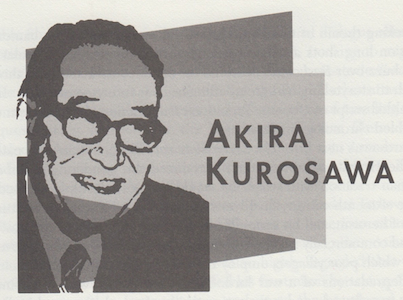Born: March 23, 1910, Omori, Japan
Died: September 6, 1998, Setagaya, Japan
His complex subject matter and superb pictorial sense were equal to those of any Western filmmakers.
—Richard Stromgren
In 1936, young Akira Kurosawa worked as an assistant director and screenwriter in an Eastern cinema studio by day, but studied Western painting, literature and political philosophy by night. A subtle blend of these passions found their way into his noteworthy scripts, particularly Judo Saga (1943), and he began to formulate a distinct, personal style as a scenario writer under the tutelage of Japan’s premiere director, Yamamoto Kajiro. However, the film that made a name for the young artist was Drunken Angel (1948), on which Kurosawa was both scenarist and director. The film also marked the beginning of a collaboration with the actor who would forever be associated with him, Toshiro Mifune. After years of serving as an apprentice, Kurosawa finally emerged as one of the most promising new directors in postwar Japan.
Then came Rashomon, the Grand Prix finalist at the Venice Film Festival in 1950. Rashomon stunned audiences with its innovative exposition and drew international raves for its artful composition. Not even the unorthodox structure of Citizen Kane (1941) used cinema to probe for truth as Kurosawa had. The film details the same event from four different points of view. Filled with dynamic acting and surprising plot twists, Rashomon’s clever narrative was accompanied by rich, black-and-white visuals; Kurosawa used harsh streams of light that penetrate the branches of a forest as a metaphor for the truth-seeking theme of the film. His skillful movement of the camera and reliance on long shots also complemented the complex and circular story. But the buzz over Rashomon centered on the deconstructed plot: this fresh approach to storytelling had great influence over future screenplays. In fact, the heralded script of Quentin Tarantino’s Pulp Fiction (1994) owes much to the jumbled chronology of Rashomon.
In Kurosawa’s next film, Seven Samurai (1954), the director paid tribute to the Hollywood western and introduced the wandering swordsman tradition with which he would be most closely associated. The Japanese sixteenth-century civil war repeatedly gave Kurosawa a setting for themes of heroism, and his series of samurai films represented his most influential and commercially successful efforts. Seven Samurai is a clever scenario in which poor villagers employ the aid of mercenaries to rid their town of the depredations of a warlord. The film expertly walks the fine line between morality tale and tense action thriller. It sparked several Hollywood remakes of notable influence, most obviously The Magnificent Seven (1960). Several filmmakers would also borrow the elegant scripts of Kurosawa’s other samurai films, including Yojimbo (1961) and Kagemusha (1980). From Yojimbo, Sergio Leone would create the perfect vehicle for his spaghetti westerns with Clint Eastwood in A Fistful of Dollars (1964). More recently, Walter Hill’s Last Man Standing (1996) used a Depression-era setting to re-create Yojimbo’s story with Bruce Willis in the lead. Despite his own adaptations of gangster films and period epics, Kurosawa’s public best loved the violent fight scenes of these samurai classics.
The two most appreciated aspects of Kurosawa’s films are his themes and his imagery. He is considered one of the finest screenwriters in film history, blending dialogue with equal parts of understated absurdity and powerful poignancy. Central to his scripts are questions of morality, and he often places his characters in inventive situations that force them to face ethical dilemmas. His detailed visual style is reminiscent of traditional Japanese art, but his photography maintains a modern look that favors high contrast and vivid color to emphasize the exploration of truth in many of his films.
Famous literary works were carefully mined by Kurosawa. He successfully adapted the plays of William Shakespeare to the screen in Throne of Blood (1957) and Ran (1985), tackling the tormented spirits of Macbeth and King Lear, respectively. Both films were hailed as among the finest film versions of the Bard’s plays. He has also written his own scripts based on Dostoevsky’s The Idiot and Edgar Allan Poe’s The Masque of Red Death. Many of Kurosawa’s literary adaptations were never filmed by were later collected and published in books.
Ikiru (1952) is generally cited as Kurosawa’s best film, ironically it was made during a period of depression in the Japanese film industry. His most accessible films, in which economy of style and minimal dialogue allowed for international appeal, were well received in the West. Looking to migrate to Hollywood in 1968, Kurosawa agreed to shoot the war spectacle Tora! Tora! Tora! For 20th Century Fox. Halfway through the Pearl Harbor attack scene, he was replaced with another director and gave up ideas of traveling abroad.
Unquestionably, Kurosawa is the best-known Eastern filmmaker. He assimilated his knowledge of ancient Japanese traditions into a modern Western art form, influencing many writers and directors along the way. His bold visual style and humanist stories had tremendous impact on the execution of films by George Lucas, Satyajit Ray, Steven Spielberg, Andrei Tarkovsky and Tony Richardson. And his success and influence on American cinema garnered attention for Kenji Mizoguchi, Yasujiro Ozu and other Asian directors. In his heyday, Kurosawa’s work was so highly regarded that veteran Hollywood director Billy Wilder expressed his frustration by saying, “I’m just going to sign up with a Japanese team and sit on the bench and wait for Kurosawa to break his leg.”
To read all the republished articles from ‘The Film 100,’ go to Reintroducing the Film 100 here on Keyframe.





